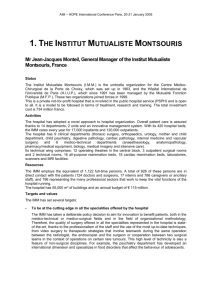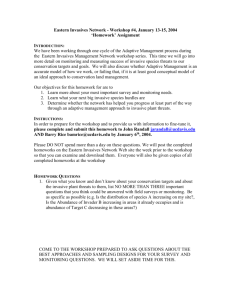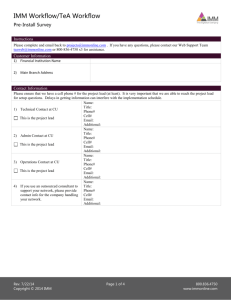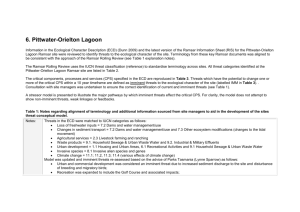8. East Coast Cape Barren Island Lagoons
advertisement
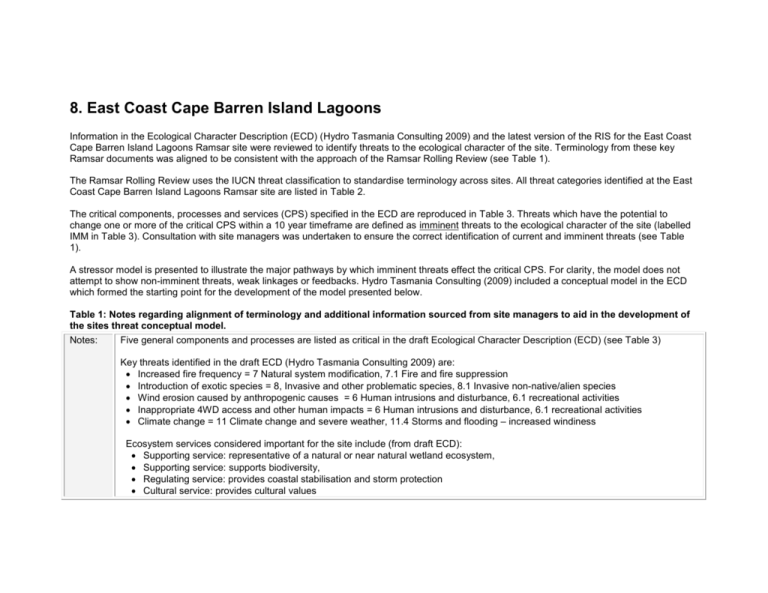
8. East Coast Cape Barren Island Lagoons Information in the Ecological Character Description (ECD) (Hydro Tasmania Consulting 2009) and the latest version of the RIS for the East Coast Cape Barren Island Lagoons Ramsar site were reviewed to identify threats to the ecological character of the site. Terminology from these key Ramsar documents was aligned to be consistent with the approach of the Ramsar Rolling Review (see Table 1). The Ramsar Rolling Review uses the IUCN threat classification to standardise terminology across sites. All threat categories identified at the East Coast Cape Barren Island Lagoons Ramsar site are listed in Table 2. The critical components, processes and services (CPS) specified in the ECD are reproduced in Table 3. Threats which have the potential to change one or more of the critical CPS within a 10 year timeframe are defined as imminent threats to the ecological character of the site (labelled IMM in Table 3). Consultation with site managers was undertaken to ensure the correct identification of current and imminent threats (see Table 1). A stressor model is presented to illustrate the major pathways by which imminent threats effect the critical CPS. For clarity, the model does not attempt to show non-imminent threats, weak linkages or feedbacks. Hydro Tasmania Consulting (2009) included a conceptual model in the ECD which formed the starting point for the development of the model presented below. Table 1: Notes regarding alignment of terminology and additional information sourced from site managers to aid in the development of the sites threat conceptual model. Notes: Five general components and processes are listed as critical in the draft Ecological Character Description (ECD) (see Table 3) Key threats identified in the draft ECD (Hydro Tasmania Consulting 2009) are: Increased fire frequency = 7 Natural system modification, 7.1 Fire and fire suppression Introduction of exotic species = 8, Invasive and other problematic species, 8.1 Invasive non-native/alien species Wind erosion caused by anthropogenic causes = 6 Human intrusions and disturbance, 6.1 recreational activities Inappropriate 4WD access and other human impacts = 6 Human intrusions and disturbance, 6.1 recreational activities Climate change = 11 Climate change and severe weather, 11.4 Storms and flooding – increased windiness Ecosystem services considered important for the site include (from draft ECD): Supporting service: representative of a natural or near natural wetland ecosystem, Supporting service: supports biodiversity, Regulating service: provides coastal stabilisation and storm protection Cultural service: provides cultural values Table 2: Major categories and subcategories of current threats for the Ramsar site. 8. East Coast Cape Barren Island Lagoons 6. Human Intrusion & Disturbance 6.1 Recreation activities 11. Climate Change & Severe Weather 11.4 Storms & flooding 7. Natural System Modification 7.1 Fire & fire suppression 8. Invasive & Other Problematic Species & Genes 8.1 Invasive non-native/alien Species 8.1 Invasive nonnative/alien Species Flora 7.1 Fire & fire suppression 6.1 Recreation activities Components, Processes and Services (CPS) (components shaded blue, processes green, services yellow) IMM IMM 11.4 Storms & flooding Table 3: Matrix of all current threats against critical components, processes, and services showing those considered to be an imminent threat to the ecological character of the Ramsar site. Fauna Geomorphology/geology sediment transport and deposition IMM IMM IMM IMM Hydrology Water quality Regulating service: Stock watering Cultural service: Cultural heritage and 7.1 Fire & fire suppression 8.1 Invasive nonnative/alien Species Supporting service: Biodiversity IMM IMM IMM Supporting service: Natural or near natural wetland ecosystems IMM 11.4 Storms & flooding 6.1 Recreation activities Components, Processes and Services (CPS) (components shaded blue, processes green, services yellow) identity IMM Key to shapes used in conceptual model. References: Hydro Tasmania Consulting (2009) Cape Barren Island Lagoons Ramsar Site ECD. Update and Review. Draft 25 th August 2009. 8. East Coast Cape Barren Island Lagoons 8. Invasive & Other Problematic Species 8.1. Invasive non native/alien Species 7. Natural System Modifications 7.1. Fire and fires suppression Increased freq. of wild fires Indicator: Number and extent of wildfires, extent of habitat loss 11. Climate Change & Severe Weather 11.4. Storms & flooding (increased windiness) Increased freq. of escaped control burns Indicator: Number of escaped control burns, extent of habitat loss 6. Human Intrusions & Disturbance 6.1. Recreational activities Increased erosion (freq. of dune blowouts) Indicator: Number and extent of blowouts, rate of encroachment Invasive species (rabbits, thistle, gorse, Marram grass, Seaspurge) Indicator: Species abundance, extent Reduced flora diversity Change in physical habitat (dune destabilisation) Component: Geomorphology Service: Near natural wetland ecosystem Change in vegetation type (shrubland to herbland) Component: Vegetation Service: Biodiversity Increased physical disturbance Indicator: Visitor numbers Facilitation of invasive species, Phytophora Altered community composition Service: Coastal shoreline stabilisation

